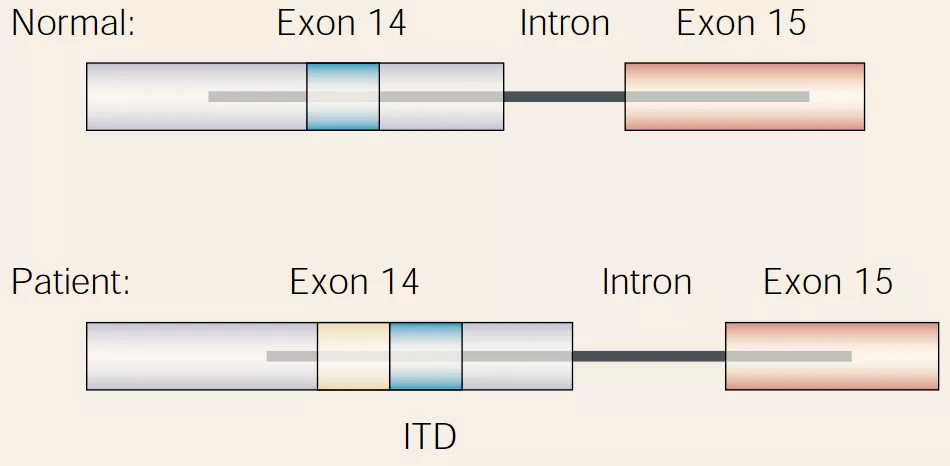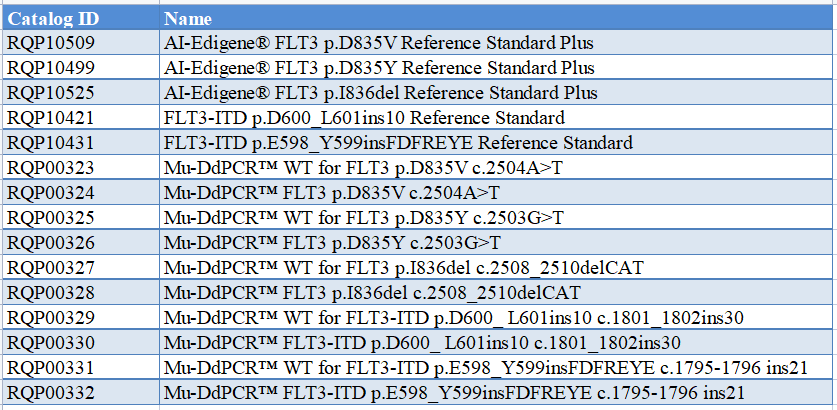FLT3 gene detection standard
Introduction to FLT3
FLT3 (Fms-like TyrosineKinase-3, CD135) is a protein encoded by the FLT3 gene. FLT3 is a cytokine receptor belonging to receptor tyrosine kinase class III. FLT3 is the receptor for the cytokine FLT3 ligand (FLT3L). FLT3 ligand (FLT3L) is secreted by bone marrow stromal stem cells and other cells, and can cooperate with other growth factors to promote the proliferation of stem cells, progenitor cells, and dendritic cells and natural killer cells. FLT3L has the function of significantly activating hematopoietic stem cells and is considered to be a stem cell growth factor. When FLT3 ligand (FLT3L) binds to FLT3, the latter dimerizes and activates autophosphorylation of tyrosine residues, thereby activating RAS and further activating downstream signaling molecules such as RAF, MAPK, and ERK kinases, which are located in the FLT3 pathway The key molecular markers of AKT, BRAF, KRAS, HRAS, NRAS, MEK1, PI3K and PTEN.
FLT3 mutation
The FLT3 gene is located on the long arm of human chromosome 13, with a full length of 97319 bp, containing 24 exons, encoding 933 amino acids. The FLT3 gene is one of the most frequently mutated genes in acute myeloid leukemia (AML). In addition, some AML patients without FLT3 mutations have high levels of wild-type FLT3 in their blasts, and these high levels may be associated with poorer prognosis. Signaling through FLT3 plays a role in cell survival, proliferation and differentiation. FLT3 mutations are mainly divided into two types of mutations: internal tandem repeat (ITD) mutations and point mutations in the activation loop (TKD point mutations), of which 2/3 of the mutations are FLT3-ITD. Both FLT3-ITD and TKD mutations can lead to abnormal activation of FLT3, resulting in continuous autophosphorylation of the FLT3 receptor independent of FLT3 ligand (FL), abnormal activation of downstream signaling pathways, and participation in the occurrence and development of leukemia.
FLT3-ITD, the internal tandem repeat of the FLT3 gene, is commonly found in exons 14 and 15 of the FLT3 gene, and its insertion length varies from 3 to several hundred base pairs, and in most cases occurs in multiples of 3. The number of FLT3-ITD mutations in each patient is generally 1-3, and the insertion position mostly covers the Y591-Y597 region of exon 14. The mutation pattern of FLT3-ITD, such as the number of mutations, insertion length, and mutation frequency, is not only a prognostic indicator of AML, but also an important consideration for AML risk stratification, which has certain guiding significance for the selection of its treatment regimen.

Fig . FLT3-ITD mutation
The FLT3-TKD mutation often refers to the point mutation of the FLT3 gene, and its mechanism of action is to change the structure of the A-Loop region to make DFG[aspartic acid (Asp/D)-phenylalanine (Phe/F)-glycine (Gly /G)] closed-structure configuration was converted to DFG open-structure configuration. It usually occurs on exon 20 of the gene, and the main mutation sites are D835, R834, I836, D839, Y842, etc.
For the detection of these two types of mutations, we can provide multiple diagnostic standards to ensure the detection limit, sensitivity and stability of the diagnostic method.
Product List

Part of the data graph display
1. AI-Edigene® FLT3 p.D835V Reference Standard Plus RQP10509

2. AI-Edigene® FLT3 p.D835Y Reference Standard Plus RQP10499

3. AI-Edigene® FLT3 p.I836del Reference Standard Plus RQP10525

4. FLT3-ITD p.D600_L601ins10 Reference Standard RQP10421

5. FLT3-ITD p.E598_Y599insFDFREYE Reference Standard RQP10431


